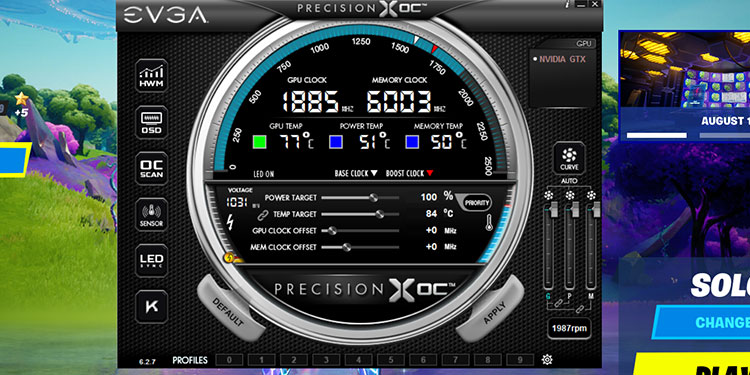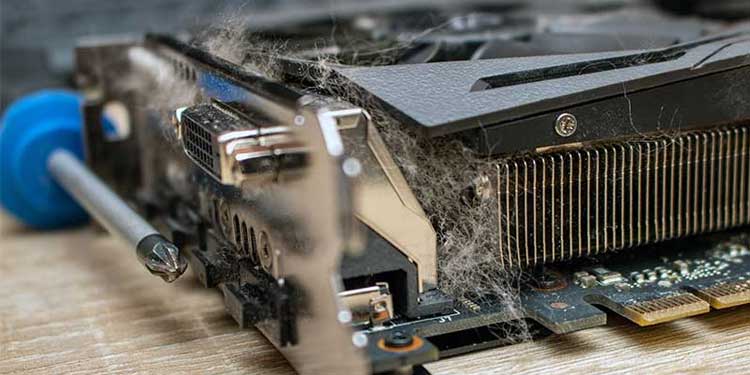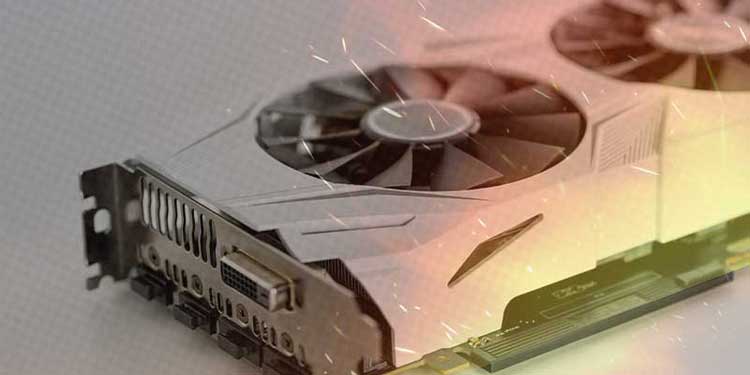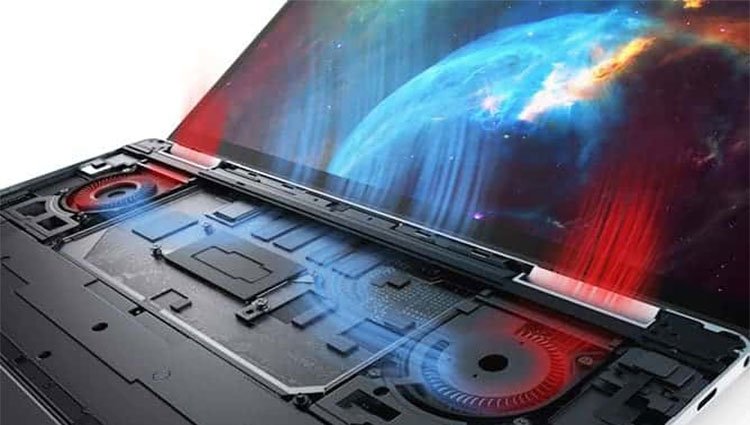Why Are My GPU Fans Not Spinning?
There are many reasons why your GPU fans might not be spinning. Basic operation and temperature control are often the roots of the problem and nothing to worry about. However, some issues could need to be addressed. For example:
The GPU isn’t hot enough for the fans to turn on yet. Many graphics cards aren’t designed to have the fans spin at idle temperatures. There’s an obstruction in the GPU fans.You have the GPU monitor Software set up incorrectly, and the fans aren’t set to turn on.There isn’t enough power getting to the GPU.
Continue to keep an eye on your temperatures. Also, note the operation of the fans and the way your computer is running. You need to be aware of any problems because they might be the clues that lead you to the cause of the problem.
Is it Actually Your Fans that need fixes?
Before you go out and start the fixes, we need to make sure if it’s actually your fans that’s the culprit. Or, see if there are any other underlying problems. There are a few different ways that you may notice a problem with your GPU fans.
Visual Inspection
Do a visual inspection of the fans themselves to see if there are any apparent issues. Look for dust or debris collecting on the fans, cords interfering with their rotation, or any misalignment that doesn’t look normal. Use a flashlight or remove the GPU from the computer to get a better look at it, if necessary.
Issues with Graphics-Intensive Software
If you have difficulty playing games — especially if the game is freezing or crashing — listen for your fans or look to see if they’re operational or changing states when the software is erroring. Sometimes the fans staying off can make the GPU operate at such a high temperature that some software won’t work correctly.
GPU Monitoring Software
Keep an eye on your GPU monitoring software because you can see at what level the fans are set. If they aren’t spinning but are set high on manual through the software, there could be a disconnection between the hardware and software. It’s also possible that the fans are dead or obstructed and aren’t responding for that reason.
Basic GPU Checkup Steps
It’s a good idea to keep up with the maintenance on your GPU, even when it’s working correctly. Doing so will help you avoid problems with your graphics card. Stopping them before they start is preferable to having to fix issues when they arise.
Check GPU for Fan Dust
Keep an eye on your GPU to see whether the card or the fan is collecting dust. If you notice it getting dusty more quickly, try to mitigate the issues that are causing that. For example, consider buying an air purifier for the room your computer is in. Dust can cause the graphics card to overheat, damage the fans, and impair your performance.
Clean GPU and Update Drivers
Use compressed air to clean your GPU, focusing on the fans to remove dust. They need to be clean and unencumbered to spin freely. Cleaning the GPU can also reduce the heat since a clean component stays cooler. Take out the GPU to clean it if it needs a deep cleaning. You can use cotton swabs to help remove stubborn stuck dust and then follow with compressed air. Otherwise, it should be fine to clean the GPU with it in the computer. Make sure to keep an eye on your drivers. If the drivers for your hardware aren’t current, you might be running a version that doesn’t deliver the best possible performance.
Install or Update GPU Monitoring Software
While you can run the GPU without monitoring software, you’re missing out on a lot of functionality. Check with the manufacturer of your card to see what GPU monitoring software they use. It’s crucial that you use the software designed by the specific manufacturer of your card. Sometimes the monitoring software will need updates. Update when new releases become available to make sure your software is current. Note that updates are released a few weeks after launch of new GPUs.
Check Connections, Cables, and Heatsinks
When you’re experiencing issues, one easy way to confirm everything is set up right is to go through the connections, cables, power cords, and heatsinks. Everything should be clean, firmly connected, and plugged into the correct ports. Even veteran builders sometimes miss a step or misconnect something — even a little bit of wiggle room in a connection can cause the GPU not to function right.
Troubleshooting
Here are few troubleshooting ideas for you to try when your GPU fans don’t seem to be functioning correctly. Knowing where the problem started can help you decide where to begin your troubleshooting. GPU fan problems are usually caused by a physical issue with your hardware, a setting in the GPU software, or a setting in your computer or BIOS.
GPU Fans Not Spinning on Startup
It’s entirely normal for your GPU fans not to spin on startup. Many GPUs will spin the fans for a second while the board does a system check but then shut off the fans until they’re needed. Try playing a game or using a program that generates heat to determine if the fans just need more time and a higher load to kick in. Games with large maps and intense graphics like ARK or PUBG are good games to generate heat on your GPU. Watch the temperature and the fans as you play to see whether they kick on once things get a little hotter.
GPU Not Spinning and Overheating
If your GPU is overheating, the most important thing is to get the temperatures down before figuring out exactly what is wrong. One thing you should check is whether the GPU is plugged into the motherboard properly. If the motherboard isn’t detecting the GPU, it might create problems with the fans. Unplug the computer before you attempt to plug in the GPU again. Once the connection is more solid, it might work better. Don’t use programs that generate a lot of heat until you’ve addressed why the fans aren’t spinning. Otherwise, you might damage your hardware. If that doesn’t fix the problem, consider some of the other fixes in this article to make the fans start working correctly.
GPU Lights on, but Fans Not Spinning
If your lights come on, but the fans aren’t spinning, it’s possible that the GPU isn’t plugged securely into the PSU or that the PSU isn’t adequate to give it enough power. Make sure to use a power supply calculator to check whether your power supply can handle all the hardware you have plugged into it. Securely plug the GPU into the PSU again once you’re sure it’s sufficient. Remember that you might have to use an adapter or a specific cable, depending on your GPU.
GPU Fans Not Spinning but Working
If your GPU fans aren’t spinning, but your GPU monitor says they’re working, you need to use a secondary GPU temperature monitor. Without fan movement, your GPU will eventually get too hot and can damage your hardware. If the fans aren’t moving even when you’re in an intensive program, you need to start troubleshooting immediately. If the fans aren’t spinning, they aren’t working correctly — even if your computer isn’t overheating. One thing to check is whether any of the cables in your PC are hitting the fan blades and keeping them from spinning. Also, make sure to blow any dust out of the graphics card fans and the rest of the computer because that can prevent it from working.
GPU Fans Not Spinning After Cleaning
Once you’ve put your GPU back into the computer post-cleaning, check to make sure the hardware is working at least as well as it was before you removed it. Check the fans, LEDs, and keep an eye on your temperature monitor. If you notice the fans aren’t spinning, remove it again and check for any issues with the blades themselves. Something may have obstructed the blades while it was out of the computer. You should also consider taking the GPU apart again if you took it apart to clean it. Carefully put it back together a second time, taking care to tighten each screw appropriately and make sure the fans are mounted correctly. If you didn’t take the GPU apart, only check the fans for obstructions. Only a person comfortable disassembling computer hardware or a certified computer repair technician should take apart a graphics card.
GPU Fans Not Spinning Automatically
If the fans aren’t spinning automatically, check your GPU monitoring program. You can create a fan curve in most programs that determine when the fans kick in. Your curve may be set too high, and the GPU isn’t hitting the target temperature. In that case, they won’t seem to turn on unless you force it. Some monitoring programs also require that you enable automatic fan control. Make sure that it’s selected on your software. Adjusting your fan curve and settings varies depending on your GPU manufacturer. Check the documentation for your program to determine how to make changes.
GPU Fans Not Spinning: BIOS Problems
If you think BIOS settings cause your GPU fan problems, reset BIOS to default settings. One of your adjustments might prevent the fans from operating correctly.
GPU Fans Not Spinning With a Black Screen
Check your motherboard manual to make sure you have all the cables in the computer appropriately connected. It’s not uncommon for someone to build a computer without consulting the motherboard manual and running into problems in the process. If everything is connected solidly, the fans aren’t spinning, and there’s no output on the screen, the GPU might be damaged or dead. If the computer won’t POST at all, your power supply, motherboard, memory, or CPU is likely damaged. You may need to replace some of your components. You can also check to be sure you’ve plugged the monitor cable into the right spot. In some cases, it should be plugged into the GPU directly and not the motherboard — if it isn’t, you might get a black screen.
CPU and GPU Fans Not Spinning
If the CPU and GPU fans won’t spin, that’s not an excellent sign for your computer. If you’ve made sure all the connections are secure and the cables aren’t damaged, another component might not be working. You should test the PSU on another computer. The motherboard may be faulty. You can also check to see whether your power supply is damaged or defective. Unfortunately, many problems can go wrong with your PC if it isn’t built just right. Anything from a crack in the arm to an improperly installed standoff can prevent components from working correctly.
GPU Fans Not Spinning When Gaming
Some games don’t run hot enough to make the fans kick on. If the passive cooling on your GPU is sufficient for the game you’re in, the fans might not spin until you switch to a game that runs hotter. Make sure the graphics card is recognized in the device manager and your GPU software. Both should be able to detect what kind of graphics card you have. If it doesn’t work even on intensive games and causes your GPU to overheat, cease playing those games until you track down the source of the issue. It’s better to figure out what’s going on than overheating your GPU and potentially damaging it.
GPU Fans Not Spinning Under Load
If you can’t get the fans to spin under load and you’ve adjusted the settings from the GPU monitoring program, you might need to swap around some hardware and test things out. Try using a new PSU in your computer to see if that makes the graphics card work. Recheck every connection in the computer during the process. You should also try using your graphics card in a completely different build to see if it works if you have the parts available. You can always ask a friend to use their computer to test your components if what they have will work with your GPU model.
Laptop Fans Not Spinning
If you’re using a laptop, the graphics card might be kept cool by all the fans in the chassis. Since laptops overheat more quickly, it’s essential to make sure they’re working at all times. If the fans aren’t spinning when idle, check whether they kick in as the laptop heats up. Make sure they’re not impaired as well. Some laptops might have a quiet mode that prevents the fans from turning on when it isn’t too warm. If the fans aren’t spinning under load, clean the vents and update your software. Turn the laptop off and then turn it back on to see whether they kick in. If they don’t, consider reaching out to a certified computer repair specialist to help you get the laptop working again. Remember that opening your laptop might void your warranty. Proceed with caution if you decide to check the connections inside the laptop.
Solutions for Fan Malfunction
If your fans aren’t working at all, there are a few steps you can take to get them going again. You don’t always need a new GPU when the fans fail.
RMA Cards Under Warranty
If your GPU is still under warranty, contact the manufacturer or the company that holds the warranty. Fans that aren’t working properly will almost certainly be covered under its terms. It’s important to keep the receipt for your GPU and to register it after purchase. Doing these things in advance might help you navigate the RMA process more quickly. Keep in mind that you may have to send the GPU in for repairs and spend a bit of time without one, depending on the company that fixes it. To find out how to properly RMA your graphics card, talk to customer support at its manufacturer. Most GPUs also come with information on the warranty in the box.
Replacing With Aftermarket Fans
Check out your options if you need to replace your fans. Some aftermarket fan creators promise even better performance than those that come standard with your GPU. Make sure that the fans you’re purchasing are compatible with your graphics card and that you’re comfortable replacing them yourself. Look for the cooling capacity, fan size, type of thermal paste, and materials when deciding between brands.
Replacing Heatsinks
While heatsinks shouldn’t be an alternative to fans — you need both for your GPU to function well — you can still improve your cooling by adding new heatsinks. Some graphics cards get hot in certain computers and builds. Anything you do to mitigate heat can provide better performance overall. Since maintaining cooler temperatures can make hardware last longer, too, replacing a heatsink might save you some money in the long run. Some users have had luck adding a heatsink to the back of a GPU, but overall it seems like making the primary heatsinks larger has a more powerful impact on cooling.
Changing Settings
If you lower your power settings and memory clock, your graphics card will run cooler. While this might impact graphically intensive gameplay, it doesn’t usually have a significant effect if you keep the changes pretty minimal. However, even a few degrees of extra cooling can help when your fans aren’t working correctly.
Water Cooling With AIO and Custom Loops
While most systems don’t require water cooling to maintain a proper temperature, it’s something to consider if yours is struggling or if you want to increase performance with overclocking. While both custom loops and AIO can be expensive, they have an equivalent impact on temperatures that other options just can’t match. An AIO comes with everything you need in a single unit. Most of them are designed to cool CPUs, and some don’t include GPU cooling. If you want to go with an AIO, make sure to look for one designed for your style of GPU. A custom loop is one you design yourself that can be run in various ways through your computer. It’s far more customizable but also takes a lot more time, attention, and maintenance. However, it will probably cool your graphics card more than an AIO since you would design and customize it for your setup. If your GPU fans aren’t spinning, any of these suggestions might help you determine what’s causing the problem. It isn’t always apparent right away, but an investigation and a little troubleshooting should root out the source of your problem. You’ll be back to hearing the hum of your GPU fans in no time.









